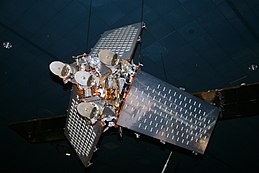
Back كوكبة أقمار إيريديوم الاصطناعية Arabic Iridium (спътник) Bulgarian Iridium Catalan Constelación satelital Iridium Spanish Iridium (téléphonie par satellite) French Iridium (műhold) Hungarian Iridium Icelandic イリジウム衛星 Japanese 이리듐 위성 Korean इरिडियम प्रकल्प Marathi
 Replica of a first-generation Iridium satellite | |
| Manufacturer | Motorola (original constellation), Thales Alenia Space (NEXT constellation) |
|---|---|
| Country of origin | United States |
| Operator | Iridium Communications |
| Applications | communications |
| Specifications | |
| Bus | LM-700 (original), EliteBus1000 (NEXT) |
| Launch mass | 689 kilograms (1,519 lb) |
| Power | 2 deployable solar panels + batteries |
| Regime | Low Earth orbit |
| Production | |
| Status | In service |
| Built | 98 (original), 81 (NEXT)[1] |
| Launched | 95 (original), 80 (NEXT) |
| Operational | 82 (76 in active service, 6 spares) |
| Maiden launch | Iridium 4, 5, 6, 7, 8 on 5 May 1997[2] |

The Iridium satellite constellation provides L band voice and data information coverage to satellite phones, satellite messenger communication devices and integrated transceivers. Iridium Communications owns and operates the constellation, additionally selling equipment and access to its services. It was conceived by Bary Bertiger, Raymond J. Leopold and Ken Peterson in late 1987 (in 1988 protected by patents Motorola filed in their names) and then developed by Motorola on a fixed-price contract from July 29, 1993, to November 1, 1998, when the system became operational and commercially available.
The constellation consists of 66 active satellites in orbit, required for global coverage, and additional spare satellites to serve in case of failure.[3] Satellites are placed in low Earth orbit at a height of approximately 781 kilometres (485 mi) and inclination of 86.4°. The nearly polar orbit and communication between satellites via Ka band inter-satellite links provide global service availability (including both poles, oceans and airways), regardless of the position of ground stations and gateways.
In 1999, The New York Times quoted a wireless market analyst, regarding people having "one number that they could carry with them anywhere" as "expensive... There never was a viable market."[4]
Due to the shape of the original Iridium satellites' reflective antennas, the first generation satellites focused sunlight on a small area of the Earth surface in an incidental manner. This resulted in a phenomenon called Iridium flares, whereby the satellite momentarily appeared as one of the brightest objects in the night sky and could be seen even during daylight.[5] Newer Iridium satellites do not produce flares.
- ^ Cite error: The named reference
nsf20180329was invoked but never defined (see the help page). - ^ "Iridium". Encyclopedia Astronautica. Archived from the original on 22 July 2017. Retrieved 13 September 2016.
- ^ Cite error: The named reference
satellite-trackingwas invoked but never defined (see the help page). - ^ Mitchell Martin (October 8, 1999). "Iridium Fails to Find a Market : Satellite Phone Misses Its Orbit". The New York Times.
- ^ "Catching a Flaring/Glinting Iridium". Visual Satellite Observer's Homepage. Archived from the original on September 25, 2013. Retrieved Dec 28, 2011.
© MMXXIII Rich X Search. We shall prevail. All rights reserved. Rich X Search